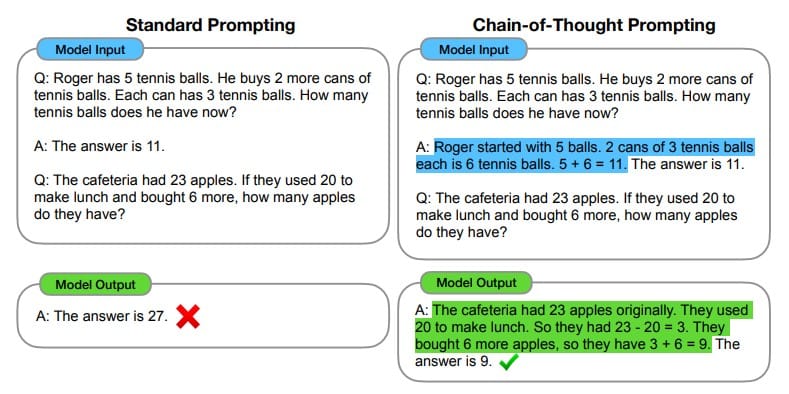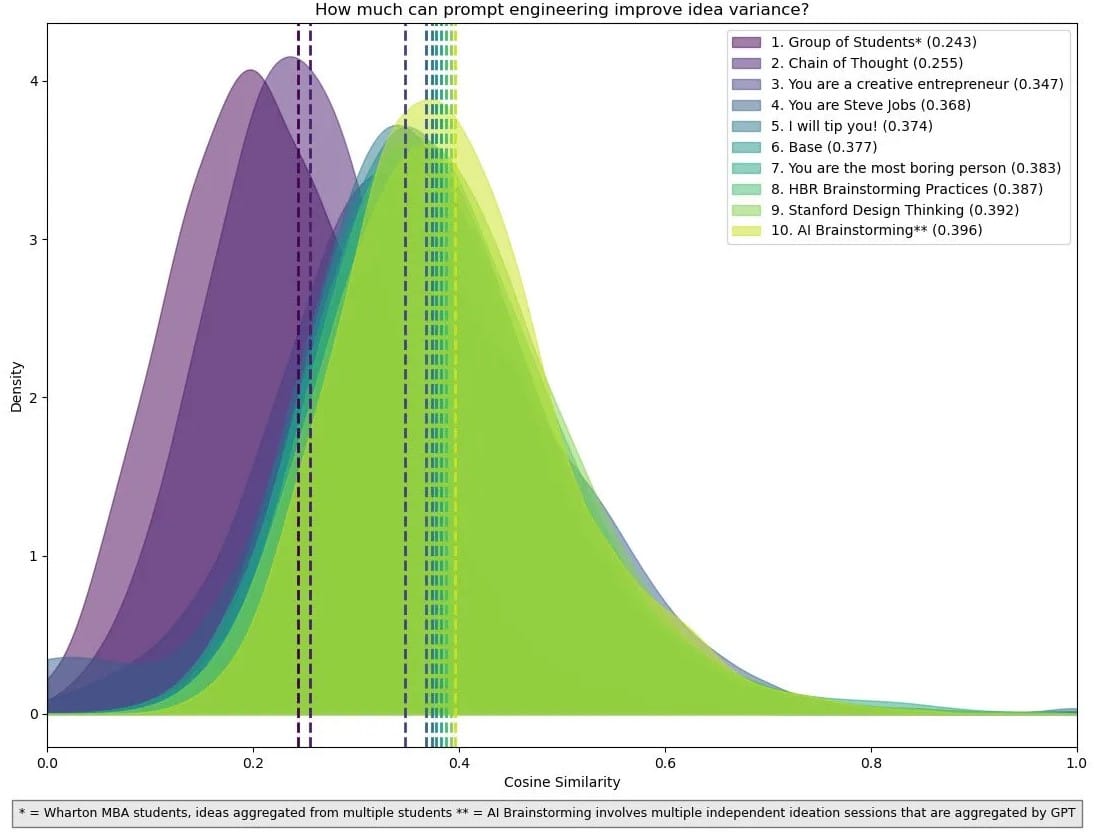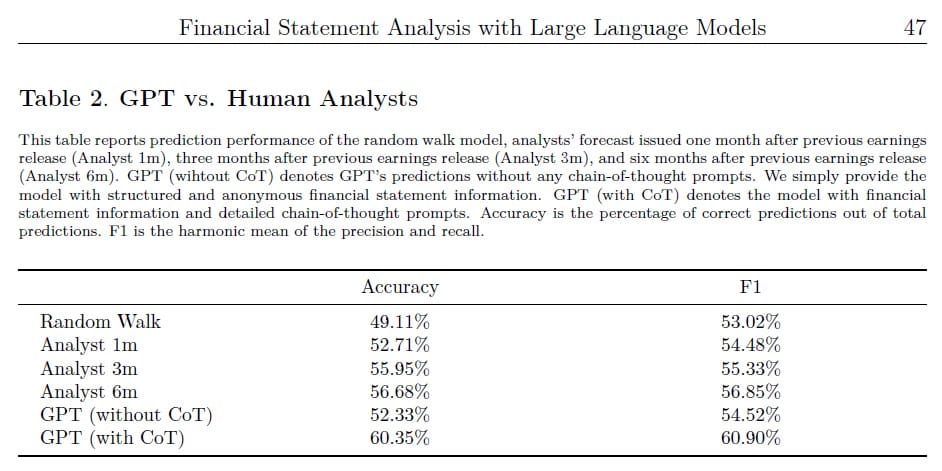
⛓️ Chain of Thought prompts yield astonishingly good results (watch out, Gordon Gekko!)
HERE IS THE PROMPT THAT BEATS WALL STREET AND WILL MAKE YOU BILLIONS!!! (I'm not kidding.)
Share this story!
The STFU prompt that beats Wall Street!
If I were a bit more populist, I would have titled this: HERE IS THE PROMPT THAT BEATS WALL STREET AND WILL MAKE YOU BILLIONS!!!
It turns out that you and I can write a prompt (an instruction) that, with the help of ChatGPT, makes us better financial analysts than those on Wall Street. If we invest according to it, we will achieve a better return than this guy.

I will show how it works and how these types of prompts can be used for much more than financial analysis.
Three tips for better results
In my talks and courses, I usually give three tips to increase the chances of getting good results when working with ChatGPT, Gemini, or any of the other tools.
- Specify who it is. If you are to develop a social media marketing campaign, specify that it is an expert in just that.
- Give examples. If you want it to write email responses very concisely and to the point, give it an example of what such an email looks like.
- Follow a chain of instructions. Ask it to first do A, then B, then C, and finally D.
The first two help the AI understand where to find the most relevant information, among all the enormous amount of data it has.
The third forces it to do a thorough job in several steps. If someone asks you to come up with ten new ideas, you can sit down and just write down what you come up with. Or you can first do an analysis, then make a long gross list, then go through it and play devil's advocate and finally update and narrow down the list to ten unique ideas.
Both methods get you to the finish line, but when you do it step by step, you end up with a better result. The AI does it the same way.
This is such a prompt that beat Wall Street. It's called the Chain-of-Thought prompt.
Chain of Thought
Even before ChatGPT was released, some researchers from Google demonstrated how chain-of-thought prompts could make large language models (like ChatGPT) perform better. First, it answered a very simple arithmetic example:
Roger has 5 tennis balls. He buys 2 cans, each containing 3 balls. How many tennis balls does he have now? The answer is 11.
The AI was given this information and then asked the following:
The cafeteria has 23 apples. If they use 20 to make lunch and buy 6 more, how many apples do they have?
The AI answered 27...
But if they instead explained step by step how they arrived at the answer 11 in the first example, the result was different:
Roger started with 5 balls. 2 cans, each containing 3 tennis balls, is 6 tennis balls. 5+6=11. The answer is 11.
When the AI was given the step-by-step explanation, it calculated correctly in the subsequent example with the apples.

Chain of Thought for ChatGPT
The above example was from 2022. Fast forward several hundred AI years to 2024, and we are now starting to see the power of this type of prompt.
In February, Professor Ethan Mollick published a paper where they compared how creative ChatGPT could be with different types of prompts. The task was to come up with product ideas. The humans, in the form of students, won, but only narrowly ahead of a Chain-of-Thought prompt.

Here's what that prompt looked like:
Generate new product ideas with the following requirements: The product will target college students in the United States. It should be a physical good, not a service or software. I'd like a product that could be sold at a retail price of less than about USD 50. The ideas are just ideas. The product need not yet exist, nor may it necessarily be clearly feasible. Follow these steps. Do each step, even if you think you do not need to. First generate a list of 100 ideas (short title only) Second, go through the list and determine whether the ideas are different and bold, modify the ideas as needed to make them bolder and more different. No two ideas should be the same. This is important! Next, give the ideas a name and combine it with a product description. The name and idea are separated by a colon and followed by a description. The idea should be expressed as a paragraph of 40-80 words. Do this step by step!
Time for Gordon Gekko to get spanked
This brings us to today. Recently, a paper was published by some researchers at the University of Chicago. They anonymized historical financial data from companies. That is, how the companies had performed. They gave this data to ChatGPT, asked it to analyze it and based on that make an assessment of how the company would perform in the coming months.
A human with a backslick and a nice suit has an accuracy over six months at just under 57 percent. ChatGPT without Chain-of-Thought reaches 52 percent and with Chain-of-Thought 60 percent.

The version of ChatGPT available to us all thus performs better than human financial analysts. 3.5 percentage points better, which in this context is a lot. Tenths are important when it involves billions of dollars. Not a special version of ChatGPT, not an AI built just for this purpose, but the same ChatGPT that can write limericks, code, and tell stories like Walt Disney. Which costs $20 a month, but can do this financial analysis in the free version. Isn't it incredible?
How did they do it?
To achieve this result, they combined my three tips. They specified that it was a financial analyst, they gave it step-by-step instructions, and they gave an example of what the result should look like.
The prompt looks very advanced when you look at it (I have included it at the end of the article) but is actually just a description of the steps a human takes when doing a financial analysis.
It thus requires knowledge to be able to put together such a prompt. But with a few weeks of research, a person who is a complete novice at financial analysis could create it.
Not just financial analysis
This type of prompt can of course not only be used for financial analysis or idea generation. It should be excellent for research, for example. Take large amounts of data, or a number of papers, and ask it to do a certain type of analysis based on that. Or help you as a business owner to develop your products. Or you as a PR manager to create more impactful messages. Or you renovating the kitchen to come up with design ideas.
What do you work with? What are you interested in? What are you knowledgeable about?
The more you can combine your special skills with ChatGPT's ability, the more powerful results you can get.
Now we all have a tool that, if we learn to use it, can make us reach expert status in a wide range of areas.
Mathias Sundin
The Angry Optimist
The prompt they used:
Instruction to ChatGPT:
You are a financial analyst tasked with analyzing a company's financial statements to predict the direction of future earnings. Follow the steps below to perform the analysis and make your prediction.
- Identify Notable Changes:
- Review the balance sheet and income statement provided.
- Identify any significant changes in financial statement items (e.g., changes in revenue, expenses, assets, liabilities).
- Compute Key Financial Ratios:
- Calculate important financial ratios that can provide insights into the company’s financial health.
- State the formula for each ratio before performing the computation.
- Compute the following ratios:
- Liquidity Ratios: Current Ratio, Quick Ratio
- Profitability Ratios: Gross Margin, Operating Margin, Net Profit Margin
- Efficiency Ratios: Asset Turnover, Inventory Turnover
- Leverage Ratios: Debt-to-Equity Ratio, Interest Coverage Ratio
- Provide Economic Interpretations:
- For each ratio calculated, provide an interpretation of what the ratio indicates about the company's financial condition.
- Explain how these ratios compare to industry benchmarks or historical performance if relevant.
- Predict the Direction of Future Earnings:
- Based on the analysis of the financial statements and the calculated ratios, determine whether the company's earnings are likely to increase or decrease in the subsequent period.
- Provide a clear binary prediction: "Earnings will increase" or "Earnings will decrease".
- Elaborate the Rationale:
- Write a paragraph explaining the rationale behind your prediction.
- Discuss the key factors and insights from your analysis that led to your conclusion.
- Additional Details:
- Estimate the magnitude of the earnings change: "large", "moderate", or "small".
- Provide a confidence score for your prediction, ranging from 0 (random guess) to 1 (perfectly informed).
Example
Financial Statements:
- [Provide the anonymized balance sheet and income statement here]
Step-by-Step Analysis:
- Identify Notable Changes:
- Example: "Revenue increased by 10% from the previous year, while operating expenses decreased by 5%."
- Compute Key Financial Ratios:
- Current Ratio:
- Formula: Current Assets / Current Liabilities
- Computation: $5,000,000 / $2,500,000 = 2.0
- Operating Margin:
- Formula: Operating Income / Revenue
- Computation: $1,000,000 / $10,000,000 = 10%
- Continue with other ratios...
- Current Ratio:
- Provide Economic Interpretations:
- "The current ratio of 2.0 indicates that the company has twice as many current assets as current liabilities, suggesting good short-term liquidity."
- "The operating margin of 10% is above the industry average, indicating strong operational efficiency."
- Predict the Direction of Future Earnings:
- "Earnings will increase."
- Elaborate the Rationale:
- "The significant increase in revenue coupled with a decrease in operating expenses has improved the operating margin. Additionally, strong liquidity ratios suggest the company is well-positioned to handle short-term obligations, which supports the expectation of increasing earnings."
- Additional Details:
- Magnitude: "moderate"
- Confidence Score: 0.85
By becoming a premium supporter, you help in the creation and sharing of fact-based optimistic news all over the world.


